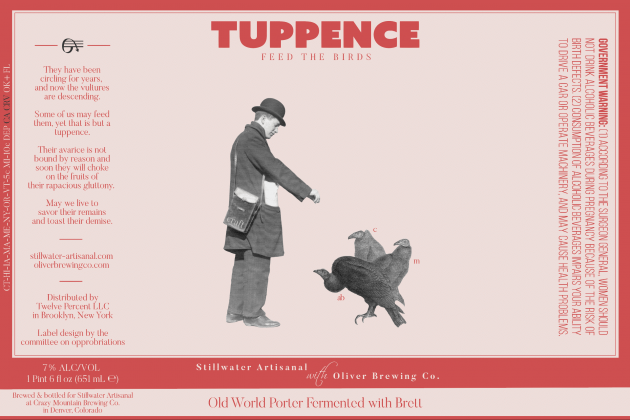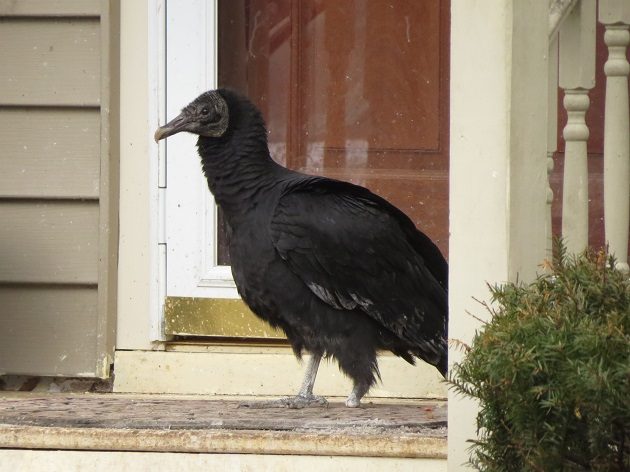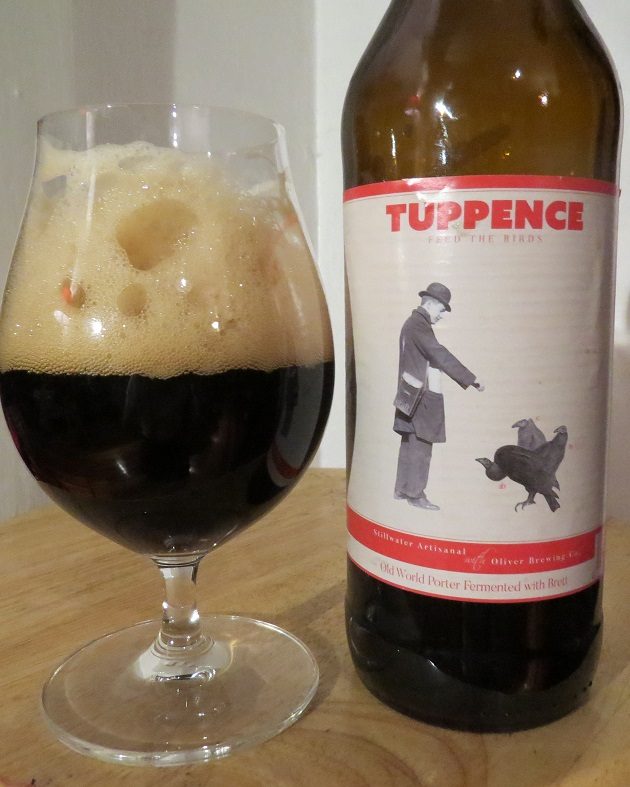
Today is the exact midpoint of winter in the Northern Hemisphere, halfway between the winter solstice and spring equinox. This means we’re also in the middle of prime feeder-watching season, and I suspect many of you have been busy filling up your backyard feeders for all the grateful little gangs of finches, chickadees, and jays.
There are some birds looking to be fed on the label of this week’s beer, too, which is an excellent collaboration from Baltimore brewers Stillwater Artisanal and Oliver Brewing Company called Tuppence (Feed the Birds). I’m not above recognizing a Mary Poppins reference as obvious as this one, but I don’t think these are the birds Julie Andrews had in mind while singing that syrupy tune – yet here we’re presented with a dapper city gent wearing a bowler, tossing crumbs to what appear to be three very out-of-range Turkey Vultures. Granted, I don’t know for sure that we’re in Edwardian London here, but that’s the geographical allusion I’m getting, pictured vagrants notwithstanding. On the other hand, birders may recall that the film features Mary Poppins singing to an American Robin perched on her hand, so maybe this practically perfect, rosy-cheeked nanny is some sort of magnet for mega-rarities – possibly of the umbrella-assisted variety.

Super-Coragyps-atratus-expialidocious!
A one-legged Black Vulture waits for its next meal, somewhere in suburban Albany, New York.
Of course, people have been feeding – and been food for – scavenging vultures since time immemorial. They’re unquestionably the birds best known for devouring human flesh, at least on a regular basis and in notable quantities. And they’re really good at it, too – in their own gruesome, vulturine way. Tibetan sky burials, Zoroastrian dakhmas, and other spectacles of avian-assisted postmortem excarnation attest to the ability of vultures to pick bones clean – and if you have some Lammergeiers around, they’ll be happy to take care of those as well.
Recently, there have even been several instances of well-meaning bird enthusiasts of dubious mental fitness (I understand these may not be mutually exclusive conditions) attracting vultures to their homes by setting out food for them, including a local story I was able to witness in person two years ago. As related in this newspaper article, a resident near Albany, New York was feeding groups of over 30 Black Vultures, much to the consternation of her neighbors. Her charity became so notorious that some friends and I paid a quick visit to her block on New Year’s Day, 2016 for our nicely staked-out, first-of-year Black Vultures. I didn’t notice any denuded cadavers lying on the homeowner’s porch, so I assume she was just feeding the birds cat food. In any case, seeing as I’ve gone from Disney soundtracks to Zoroastrian funeral practices to suburban wildlife nuisances in just a few short paragraphs, let’s just skip ahead to the beer review already.
Tuppence (Feed the Birds) is described as an “Old World Porter fermented with Brett”, with this last item referring to funky wild yeasts of the genus Brettanomyces that we’ve now encountered in several beers here at “Booze and Birds”. Porter is one of the oldest of modern beer styles and 18th and 19th century examples were often aged or “vatted” as stock ales, allowing slow-acting wild yeasts enough time to contribute their characteristic flavors. So, there’s probably a historical precedence to this practice, though Tuppence is fermented with nothing but Brettanomyces, a daring but increasingly popular use for what is regarded by many as a spoilage yeast. The “Old World” description may serve to distinguish it from modern American porters loaded with West Coast hops, and I also suspect Tuppence was made with a good amount of brown malt, a somewhat old-fashioned grain that was once the workhorse of historical porter production in Britain, known for producing rich bready and toasty flavors. Whatever the grist, Tuppence is colored a deep chestnut brown with burgundy highlights, topped with an enduring head of billowing, beige mousse.

Come feed the little birds, show them you care.
And you’ll be glad if you do. Their young ones are hungry.
Their nests are so bare. All it takes is tuppence from you
Rest assured there’s nothing cadaverous about the aroma of Tuppence, but there’s no doubt about the presence of Brett in this beer, with its telltale fragrances of roasted pineapple, white cardamom, peat smoke, and old leather. Instead of the obvious roasted coffee flavors of most porters, the dark malts here express themselves as chocolate ganache, toasted hazelnuts, cherry cordial, and toffee, complemented by an earthy but subtle hop aroma. The palate starts with a slightly acidic, vinous tinge, before giving way to blackcurrant lozenges, cocoa powder, and toasted bread crust. The body is light and drinkable, especially when compared to the swaggering richness of modern American porters, and Tuppence finishes with a cleanly medicinal, quinine bitterness with just a touch of roast. Certainly, Tuppence plays with some eccentric flavors, but crafts them into a well-rounded and beguilingly complex porter.
So, go ahead and feed the birds – even the vultures. But that’s just my two cents – er, tuppence.
________________________________________________________________________________
Stillwater Artisanal with Oliver Brewing Co.: Tuppence (Feed the Birds)
![]()
![]()
![]()
![]()
![]()
Four out of five feathers (Excellent)











Leave a Comment